Stihl carburetor adjustment
Table of Contents
The carburetor is a very important component of Stihl chainsaws. This is because it regulates the fuel and air mixture that the chainsaw needs to run correctly. Adjusting the carburetor helps to ensure that the engine performs at an optimal level. It also decreases the
Improperly adjusting your carburetor can have terrible consequences. If there is too much air and not enough fuel, your engine may overheat and blow out. On the other hand, if there is too much fuel and an insufficient amount of air, the power output will reduce due to incomplete combustion.
More recently produced Stihl chainsaws have an M-tronic engine management system that eliminates the need for carburetors. However, there are still many Stihl models on the market that require you to manually adjust the carburetor.
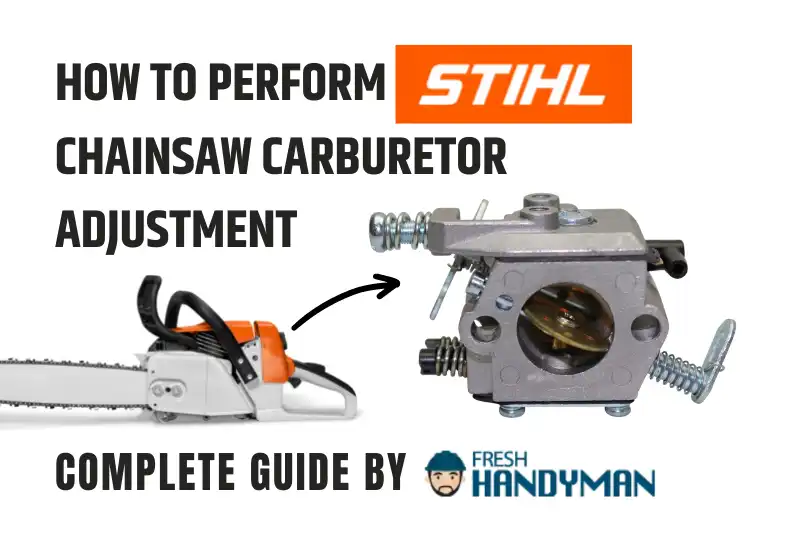
In this article, I will go over the step-by-step procedure for making a Stihl chainsaw carburetor adjustment. Keep reading to learn more about it.
Pre-adjustment preparation
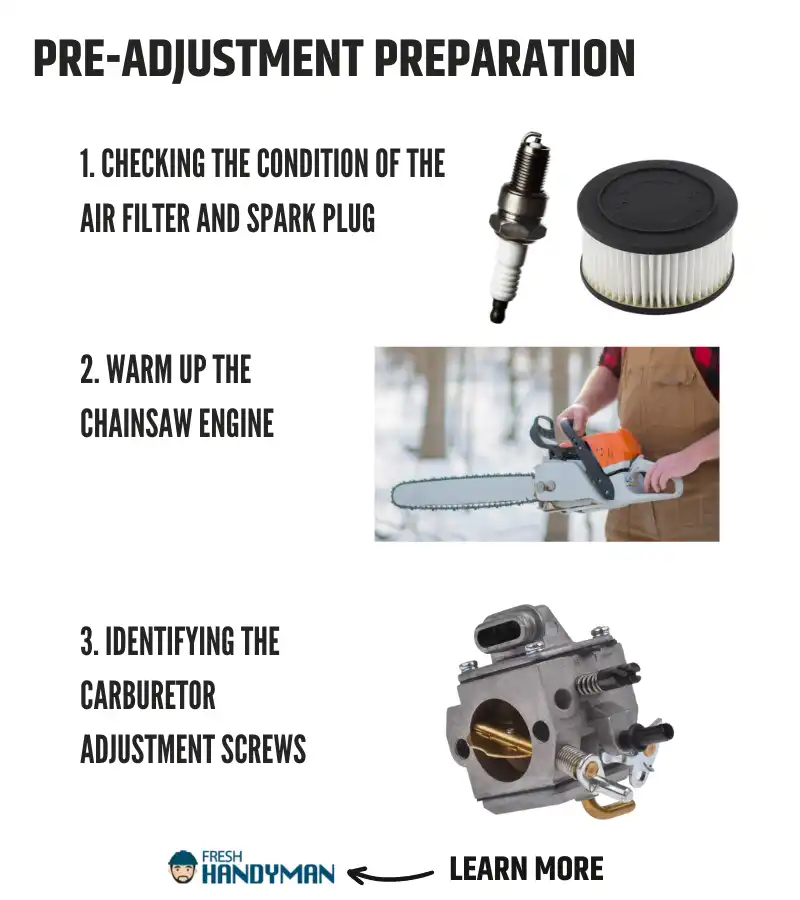
There are a few things that you’ll need to do before adjusting the carburetor to ensure that you get the best results.
- Checking the Condition of the Air Filter and Spark Plug
First, you will need to check the air filter to see if it is dirty or clogged. The air filter is responsible for cleaning the air that flows to the carburetor, so it needs to be clean and in good condition. Take out the air filter cover by turning the knob counterclockwise and lifting it off.
If the air filter is dirty, clean it with soapy water and let it dry. Alternatively, you can use compressed air to clean it. However, if it is already clean, proceed to inspect the spark plugs. However, if the filter is damaged, thus restricting airflow to the carburetor, just take it out and put in a new one.
Second, check the spark plugs to ensure that they are not dirty or worn out. This is because it will be difficult to fire up the chainsaw with dirty or faulty spark plugs. Clean them using an old toothbrush if they are just dirty and not damaged. Replace them with new ones if they are damaged.
- Warm Up the Chainsaw Engine
Next, you’ll need to warm up your engine. Rev it up for a few minutes to ensure that the carburetor is operating at the correct temperature. This will provide a more accurate baseline for adjustment.
Ensure your air filter is on and the bar and chain are on. Warm up your machine outside or in a well-ventilated area. Additionally, put on some ear muffs as a safety precaution.
- Identifying the Carburetor Adjustment Screws
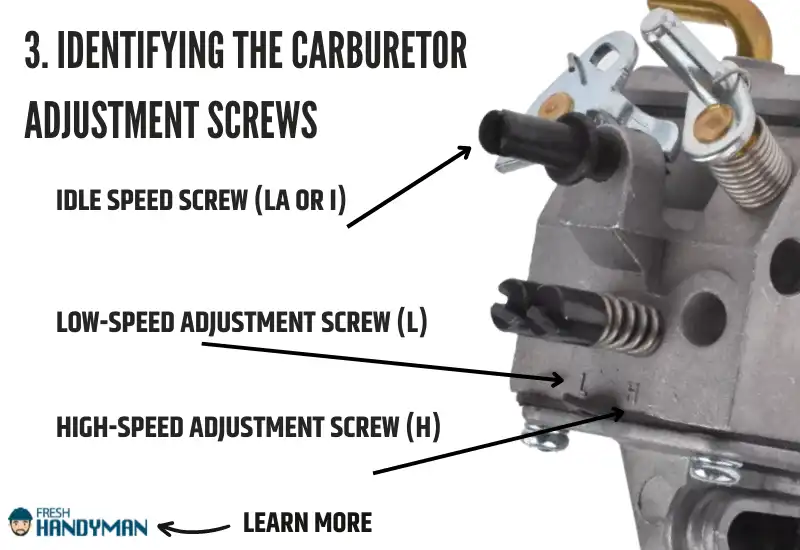
The last thing you’ll need to do before adjusting your carburetor is to identify the carburetor adjustment screws. Stihl chainsaws typically include three carburetor adjustment screws:
- Idle Speed Screw (LA or I)
The idle speed adjustment screw controls the speed of your chainsaw when it is idle. It does this by regulating the air-fuel mixture that is delivered to the carburetor. This screw should be adjusted to the point where the chainsaw does not turn off but also does not rotate too quickly to cause injury.
- Low-Speed Adjustment Screw (L)
The low-speed adjustment screw, usually marked L, adjusts the fuel-air mixture when the chainsaw is set at idle. When it is loose, the chainsaw can rapidly lose power and shut off.
On the other hand, when it is tightened, your chainsaw will respond instantly when you pull the trigger, and it will go up to maximum RPM without bogging. However, the engine might stop if this screw is overtightened.
- High-Speed Adjustment Screw (H)
The high-speed screw regulates the air-fuel mixture when you’re operating the chainsaw at high RPMs. The more you screw it in, the faster the chain goes, and the reverse is also true. However, turning this screw too far in might cause the engine to blow.
You might also be interested in: Stihl MS 391 Problems, Troubleshooting with Solutions
How to Adjust a Carburetor on a Stihl Chainsaw
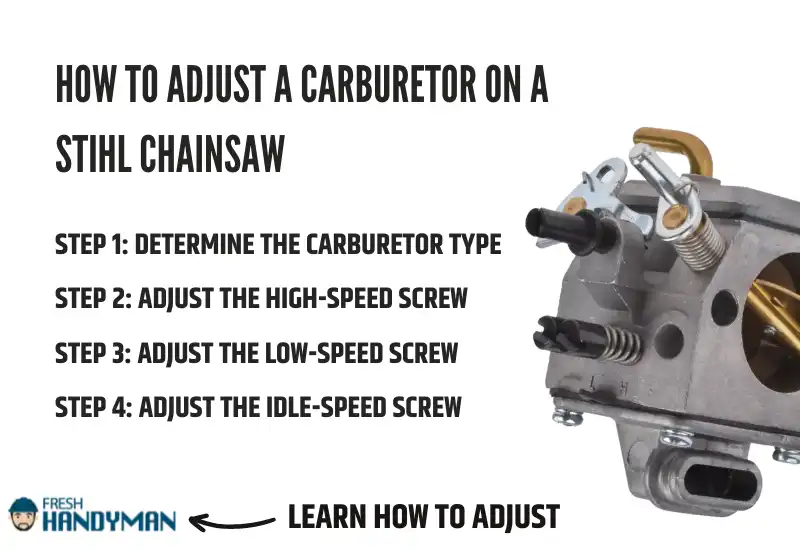
If you’ve already carried out the pre-adjustment preparation, then you can proceed to adjust the Stihl chainsaw carburetor. It involves fine-tuning three screws: idle, low adjustment, and high adjustment. Here are the steps to adjust your Stihl chainsaw carburetor:
Step 1: Determine the Carburetor Type
You will first need to determine the type of carburetor your machine has before adjusting it. I usually do this by turning the “L” screw in a clockwise direction. If it completes one revolution, then your machine has a Type A carburetor. However, if it goes below that, your machine has a Type B carburetor.
Step 2: Adjust the High-Speed Screw
To adjust the high-speed screw, you will need a flathead screwdriver. Start by turning the screw counterclockwise until it stops. This helps open the carburetor so more fuel can get into the engine. Some Stihl chainsaws have a limiter cap that prevents you from overturning the screw.
Next, turn on your chainsaw and allow it to run. Now listen to the sound to determine when it reaches the maximum RPM. A high-pitched sound should indicate this. The chainsaw also runs the smoothest at this point. Alternatively, you can place a digital tachometer over the spark plug, and it will give you the RPM value.
If you don’t hear this sound, turn the screw counterclockwise until you can find the point where the RPM value is highest. If it is over revving, then you can just turn this screw in until you find the sweet spot.
Step 3: Adjust the Low-Speed Screw
To adjust the low-speed screw, turn it counterclockwise using a flathead screwdriver until it stops. As I mentioned above, this enables more fuel to get into the engine by opening the carburetor.
Next, turn the screw in the clockwise direction until you hear the engine running smoothly while the chainsaw is idling.
If the engine continues to sound rough, turn the screw counterclockwise again and mark the point where it runs the smoothest. Once you’ve determined this point, turn the screw clockwise (to reduce fuel intake) just until the engine begins to run a little bit rougher again. This is the optimum point for idle speed and acceleration.
Step 4: Adjust the Idle-Speed Screw
Lastly, fire up your chainsaw and allow it to warm for a few minutes before turning the “LA” screw by a quarter rotation to halt the chain.
Fine-Tuning and Testing
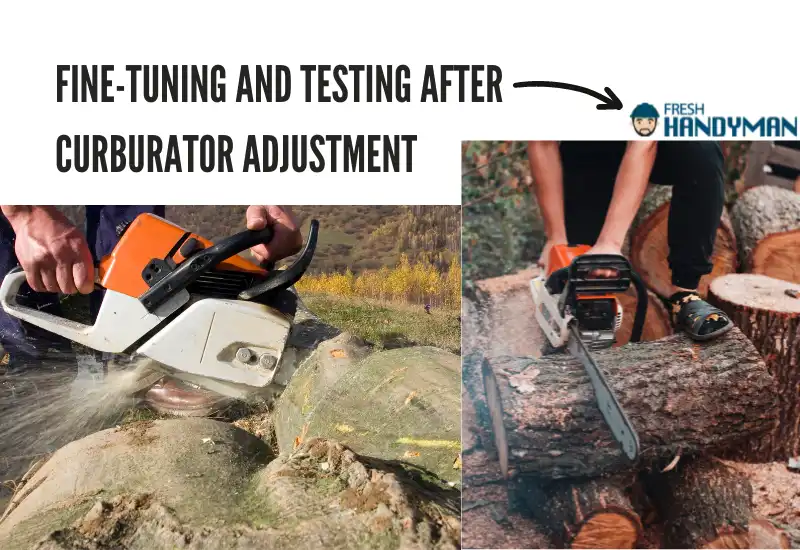
I always fine-tune and test my chainsaw after adjusting the carburetor to help it achieve peak performance and prevent wastage of fuel. Here’s what you can do to improve yours.
Adjust the low-speed screw by turning it gradually while observing the chainsaw’s acceleration. Continue adjusting until you find a sweet spot where the saw does not stall when idling but also accelerates smoothly once you pull the trigger.
After you’ve found the perfect low-speed setting, move on to the high-speed screw. Similarly, make minor adjustments by turning the screw gradually clockwise and counterclockwise while observing the saw.
Find a point where the engine revs properly at the maximum RPM. If you notice any smoke, then this may be an indication that your chainsaw is overheating. You may need to tighten your high-speed screw for more fuel to be allowed into the engine.
Test the saw by cutting wood to see if it has enough power or if you need to adjust the carburetor. Finally, if the chainsaw makes unusual noises, then one of your components might be worn out or damaged. The problem might not be an improperly adjusted carburetor.
Frequently Asked Questions
What Tools Do I Need to Adjust a Stihl Chainsaw Carburetor?
You will need a flathead screwdriver for turning the screw, a digital tachometer for reading the RPM, and a flat working surface.
How do you adjust the H and L screws on a Stihl chainsaw?
A flathead screwdriver is required to adjust the high-speed and low-speed screws on a Stihl chainsaw. Turn them counterclockwise to allow more fuel into the engine and clockwise to decrease the fuel intake.
What is the LA adjustment on a Stihl?
It is the idle adjustment screw on Stihl chainsaws. Its main function is to regulate the fuel-air mixture when the chainsaw is idling.
Final Verdict
Stihl chainsaw carburetor adjustment is important if you want your machine to perform at its peak. In addition, it minimizes the chances of an idle chainsaw injuring you. If you follow the steps I have outlined in this article, you should have an easy time adjusting your saw.
Always remember to put on the right safety gear before you start adjusting your carburetor. Once you’re done, test the chainsaw and fine-tune the adjustments if necessary.